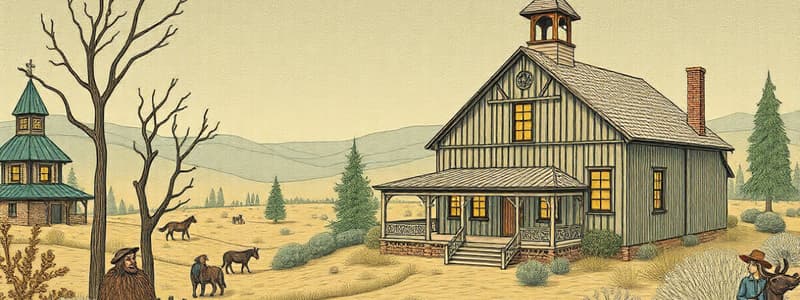Podcast
Questions and Answers
What was a key factor in the development of boom towns in the West?
What was a key factor in the development of boom towns in the West?
- The discovery of gold (correct)
- The Indian Appropriation Act
- The Homestead Act
- The construction of railroads
What was a major objective of the Granger movement?
What was a major objective of the Granger movement?
- To encourage the assimilation of Native Americans into American society
- To regulate the fees charged by railroads and grain elevators (correct)
- To promote the development of national parks
- To limit the influence of big business on government
Which of the following was a significant consequence of the Industrial Revolution in America?
Which of the following was a significant consequence of the Industrial Revolution in America?
- A decline in the importance of railroads
- An increase in the demand for skilled labor (correct)
- An increase in the number of farmers
- A decrease in the number of immigrants entering the country
What was the main purpose of the Indian Appropriation Act of 1871?
What was the main purpose of the Indian Appropriation Act of 1871?
Which of the following was a significant factor contributing to the rise of the Populist Party?
Which of the following was a significant factor contributing to the rise of the Populist Party?
Which of the following business practices contributed to the rise of monopolies during the Gilded Age?
Which of the following business practices contributed to the rise of monopolies during the Gilded Age?
What was a primary goal of the Women's Christian Temperance Union (WCTU)?
What was a primary goal of the Women's Christian Temperance Union (WCTU)?
How did the Interstate Commerce Act (1887) attempt to address the problems of the Gilded Age?
How did the Interstate Commerce Act (1887) attempt to address the problems of the Gilded Age?
What were the major social and economic changes brought about by the Industrial Revolution?
What were the major social and economic changes brought about by the Industrial Revolution?
What was the main goal of the American Federation of Labor (AFL)?
What was the main goal of the American Federation of Labor (AFL)?
What is the significance of the Battle of Little Bighorn in the context of Native American Policy?
What is the significance of the Battle of Little Bighorn in the context of Native American Policy?
What was a major motivation for the westward expansion of settlers in the late 19th century?
What was a major motivation for the westward expansion of settlers in the late 19th century?
What were the major causes of the Great Railroad Strike of 1877?
What were the major causes of the Great Railroad Strike of 1877?
What was the significance of the Chinese Exclusion Act of 1882?
What was the significance of the Chinese Exclusion Act of 1882?
What was the main purpose of the Sherman Antitrust Act (1890)?
What was the main purpose of the Sherman Antitrust Act (1890)?
Boss Tweed was notorious for what type of activity?
Boss Tweed was notorious for what type of activity?
What was the central idea of Social Darwinism?
What was the central idea of Social Darwinism?
Flashcards
Homestead Act
Homestead Act
Provided 160 acres of land to settlers if farming was undertaken.
Pacific Railroad Act
Pacific Railroad Act
Government funded railroads for westward expansion.
Conservationist Movement
Conservationist Movement
Debate on corporate control vs. public resources management.
Sierra Club
Sierra Club
Signup and view all the flashcards
Granger Laws
Granger Laws
Signup and view all the flashcards
Indian Appropriation Act (1871)
Indian Appropriation Act (1871)
Signup and view all the flashcards
Battle of Little Bighorn
Battle of Little Bighorn
Signup and view all the flashcards
Vertical Integration
Vertical Integration
Signup and view all the flashcards
Trusts
Trusts
Signup and view all the flashcards
Knights of Labor
Knights of Labor
Signup and view all the flashcards
Populist Party
Populist Party
Signup and view all the flashcards
Chinese Exclusion Act (1882)
Chinese Exclusion Act (1882)
Signup and view all the flashcards
Interstate Commerce Act
Interstate Commerce Act
Signup and view all the flashcards
Sherman Antitrust Act
Sherman Antitrust Act
Signup and view all the flashcards
Women's Christian Temperance Union
Women's Christian Temperance Union
Signup and view all the flashcards
Study Notes
Post-Civil War Expansion
- Homestead Act: Offered 160 acres of land to settlers for cheap prices if they farmed it, encouraging westward migration.
- Pacific Railroad Act: Provided funding to build a transcontinental railroad, facilitating westward expansion.
- Conservation Movement: Disputes arose over corporate interests versus public control of natural resources (land, water).
- Government Agencies: Department of the Interior and US Fish Commission established to protect land, resources, and fisheries.
- Sierra Club: Founded by John Muir, advocating for preservation and conservation of natural resources
Granger Laws and Commerce Act
- Granger Laws: State laws aimed to regulate railroad and grain elevator fees for farmers.
- Commerce Act: Law requiring railroads to set fair pricing for transporting crops and goods.
Manifest Destiny and Westward Expansion
- Gold Discoveries: Gold discoveries (e.g., Pikes Peak) led to boom towns like Denver and Boulder.
- Boom Towns: Rapidly developed towns due to gold or other resource discoveries.
Native American Policy
- Indian Appropriation Act (1871): Ended federal recognition of Native American nations' sovereignty, nullifying existing treaties.
- Reservation System: Limited areas of land assigned to Native American tribes by the federal government.
- Conflicts: Battles like Little Bighorn and Wounded Knee resulted from conflicts due to Native American policies.
- Assimilation Policies: Native American children were often forced into boarding schools to assimilate.
Industrial Revolution
- Transformation: An agrarian society transitioned to an industrial one, generating economic opportunities.
- Management Revolution: Primarily in the North, this saw new management methods in factories.
- Improvements: Railroads, electrical power, and fossil fuels drove industrialization.
- Vertical Integration: Companies controlled all aspects of production, from raw materials to finished goods.
- Trusts: Groups holding management stock to reduce and eliminate competition.
- Horizontal Integration: Merging companies into a single entity to dominate an industry.
- Oil Industry Rise: Growth of oil companies and the oil industry.
- Laissez-faire: Concept that minimal government regulation is best for business.
- New South: Southern economy industrializing, while predominantly remaining agricultural.
- Sharecropping: Labor system in the South where African Americans and poor whites worked on land owned by others.
- Textile Factories: Increased presence in the South.
Labor in the Industrial Revolution
- Poor Working Conditions: Low wages and dangerous working conditions for workers.
- Deskilling: Skilled workers lost independence due to industrialization.
- American Federation of Labor (AFL): Focused on skilled workers, led by Samuel Gompers, advocating for wages and conditions.
- Health Hazards: High worker death rates and injuries due to dangerous conditions.
- Unskilled Labor: Mostly comprised of women and children, with limited skills and pay.
- Strikes: Great Railroad Strike (1877) and other strikes highlighted worker grievances.
- National Guard: Formed to enforce domestic order during strikes.
- Knights of Labor: Advocated for worker control of industries, including ordinary workers.
- Haymarket Square: Labor strike with a bombing, causing the death of anarchists.
Farmers and Government Intervention
- Farmer Challenges: Farmers struggled with mechanized agriculture and railroad power.
- Populist Party: A new political party advocating for a federal price support system to improve farmer conditions.
- Farmers' Alliance: Group of farmers concerned with their situation.
- Grange Movement: Provided social and educational activities to farmers.
- Government Intervention: Interstate Commerce Act and Sherman Antitrust Act regulated businesses and monopolies.
Immigration and Internal Migration
- Immigration Waves: Increased immigration from Western and Southern Europe.
- Chinese Immigration: Rose after the gold rush and Burlingame Treaty.
- Westward Movement: Settlers moved west due to the Homestead Act and transcontinental railroad.
- Urbanization: Mass migration to urban areas.
- African American Migration: Increased movement to cities.
Responses to Immigration
- Chinese Exclusion Act (1882): Limited Chinese worker immigration.
- American Protective Association: Anti-Catholic group.
- Literacy Tests: Proposed to exclude immigrants from Southern and Eastern Europe.
- Socialist Party: Challenged the capitalist system.
Gilded Age Social and Political Issues
- Social Darwinism: The idea that wealth and success are determined by natural talent and effort.
- Fundamentalism: A belief in the literal truth of the Bible.
- Maternalism: Emphasis on women's roles as mothers.
- Women's Christian Temperance Union: Advocated for alcohol prohibition.
- Political Corruption: Examples included Boss Tweed's control of New York City politics.
YMCA and National Parks
- YMCA: Combining Christian faith with physical fitness.
- National Park Service Act (1916): Established federal government oversight of national parks.
Studying That Suits You
Use AI to generate personalized quizzes and flashcards to suit your learning preferences.




